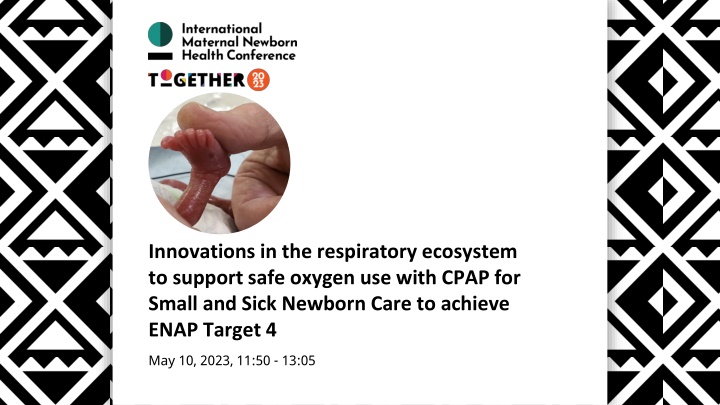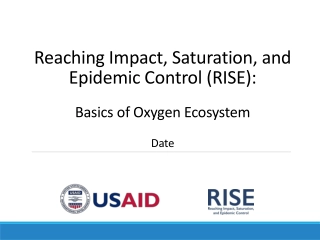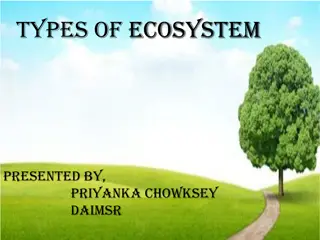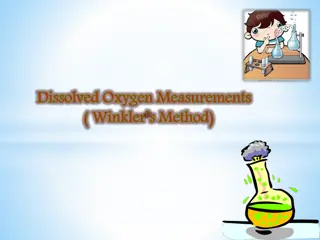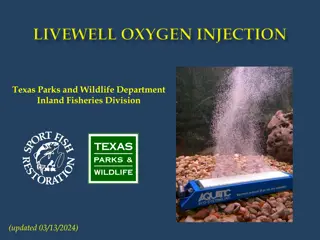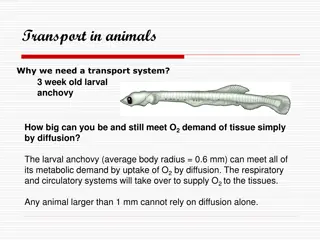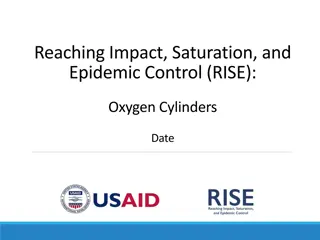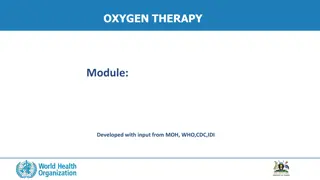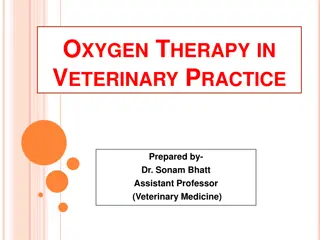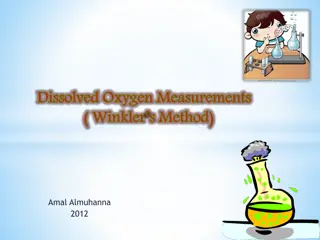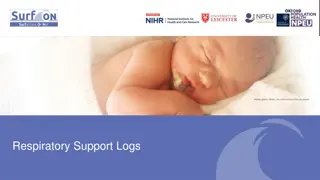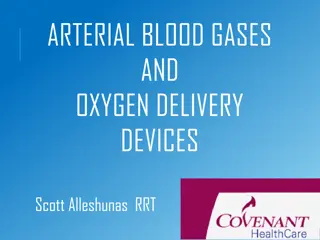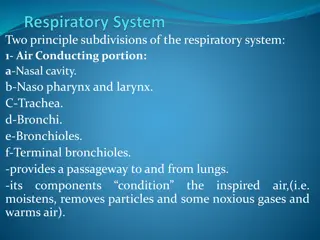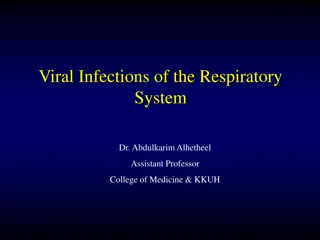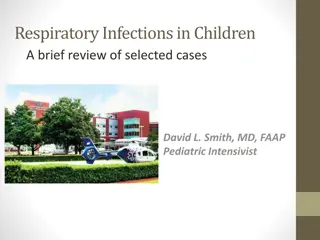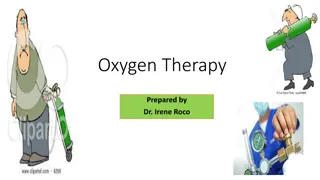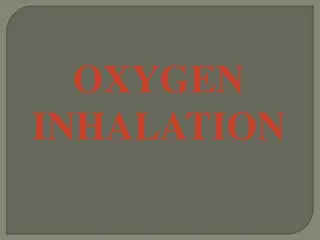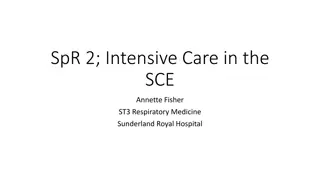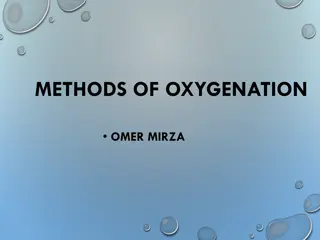Innovations in the Respiratory Ecosystem for Safe Oxygen Use with CPAP
The focus is on supporting safe oxygen use with CPAP for small and sick newborn care to achieve ENAP Target 4. Explore the various components of the oxygen ecosystem and strategies to drive collaboration and innovation within the maternal and newborn health community. Learn from experts like Dr. Leah Greenspan on advancing newborn care globally through effective implementation strategies.
Download Presentation

Please find below an Image/Link to download the presentation.
The content on the website is provided AS IS for your information and personal use only. It may not be sold, licensed, or shared on other websites without obtaining consent from the author.If you encounter any issues during the download, it is possible that the publisher has removed the file from their server.
You are allowed to download the files provided on this website for personal or commercial use, subject to the condition that they are used lawfully. All files are the property of their respective owners.
The content on the website is provided AS IS for your information and personal use only. It may not be sold, licensed, or shared on other websites without obtaining consent from the author.
E N D
Presentation Transcript
Innovations in the respiratory ecosystem to support safe oxygen use with CPAP for Small and Sick Newborn Care to achieve ENAP Target 4 May 10, 2023, 11:50 - 13:05
To achieve the 2030 SDG-era targets, IMNHC 2023 aimed to lead with evidence, share effective implementation strategies, review joint progress, and nurture collaboration and innovation within the maternal and newborn health community 2
Quick Facts Over 1600 attendees Over 180 different sessions held Four days Official delegations from the Ministries of Health of 28 countries Over 95 countries represented 3
Conference Objectives Enable pathways to drive collaboration, coordination, cross-country learning, and alignment within the maternal and newborn health community. Lead with evidence, share successes and effective implementation strategies, and identify promising solutions to improve maternal and newborn health and prevent stillbirths. Review and recognize country, regional, and global progress toward MNH targets and milestones. Prioritize actions to accelerate progress towards meeting the 2030 Sustainable Development Goals. Build a dynamic community, including engaging the next generation of leaders. 4
Oxygen Ecosystem for ALL Transport to higher level facilities Photovoltaic Systems Back-up Generators Surge Suppressors SPARES Valves Temperature probes Spare parts Flowmeters Blenders Humidification Masks Hood CPAP Nasal Cannulae Ventilators Legend: _______ Required connections Oxygen Analyzer Pulse Oximetry and probes Oxygen Concentrators Oxygen Cylinders Oxygen Plant - - - - - - - - May require connections
Chasing the ENAP target with safe and effective oxygen from the Respiratory Ecosystem lens Dr. Leah Greenspan, Senior Newborn Advisor and Neonatologist, USAID Global Health Bureau Dr. Leah Greenspan is a board-certified Pediatrician and Neonatologist. She has worked clinically in the Washington DC area for almost 20 years. Dr. Greenspan has extensive experience working in Global Health with a focus on newborn health in Sub Saharan Africa and Asia. Prior to joining the team at USAID as Sr. Newborn Advisor in March of 2020, she worked with multiple NGOs as a Newborn Consultant developing and implementing programs both in the rural and urban settings to build the capacity of medical professionals and strengthen health systems around the continuum of maternal newborn care. As a member of the Newborn Team at USAID, Leah is a Senior Newborn Advisor focusing on advancing small and sick newborn care globally as well as being a key member of the MCHN Office Commodities and Supply chain team, co-lead of Every Newborn Action Plan- Commodities team and co-lead for the MCHN oxygen coalition.
Why? 63 Countries off track to meet the SDG for Newborn Mortality Rate (NMR) 30 Million newborns require inpatient care each year 1 in 5 Children that reach a health facility needing oxygen support actually receive it Prematurity is the number one cause of neonatal mortality with respiratory distress syndrome contributing to 45% of case-fatality rates 1 CPAP is the one intervention with the greatest impact on preterm mortality Cochrane review found that CPAP reduces the risk of mortality by 48% 100% Oxygen use, improvised circuits and unregulated pressures can lead to ROP, BPD and brain injury
Newborn specific global guidance Quality statement 8.3: Equipment designed specifically for the medical care and developmental and emotional support of small and sick newborns is available at all times CPAP therapy is recommended in preterm infants with clinical signs of RDS CPAP therapy is considered immediately after birth for very preterm infants (<32weeks) with/without signs of RDS For preterm infants who need CPAP therapy, bCPAP may be considered rather than other pressure sources
Immediate newborn care (delayed cord clamping, drying, skin to skin etc.) Neonatal resuscitation for those who need it Breastfeeding early initiating and support Essential newborn care identification and referral of complications Targeted care as needed (e.g., PMTCT of HIV) Level 1 Immediate and essential newborn care Thermal care including KMC for all stable neonates < 2,000gms Assisted feeding and IV fluids Safe administration of oxygen Detection and management of neonatal sepsis with injection antibiotics Detection and management of neonatal jaundice with phototherapy Detection and management of neonatal encephalopathy Detection and referral/management of congenital abnormalities Management of preterm respiratory distress with CPAP Level 2 Special newborn care Follow up of at-risk newborns Exchange transfusion Transition 80% of countries have a national implementation plan that is being implemented in at least half the country, with an appropriate number of functional level-2 inpatient units linked to level-1 units to care for small and sick newborns, with family-centered care. Coverage Target 4 Global target 80% of districts (or equivalent subnational unit) have at least one level-2 inpatient unit to care for small and sick newborns, with respiratory support including provision of continuous positive airway pressure National and Subnational targets
Safe and effective oxygen use Oxygen is essential for life but it can also be toxic FIRST, DO NO HARM Common practices that can harm newborns: 100% oxygen administration Unmonitored oxygen Prophylactic administration without clinical indication Interrupted oxygen administration Oxygen toxicity can lead to: ROP and vision impairment #1 cause of child blindness BPD increases the risk of long-term respiratory complications with increased hospitalizations, greater need for respiratory medications and respiratory morbidities
What is the respiratory ecosystem? Respiratory ecosystem is a set of processes, tools, and technologies deployed to address respiratory conditions across the MNCH continuum of care For newborns, it includes a bundle of interventions for safe and effective oxygen provision
Oxygen Ecosystem for ALL Transport to higher level facilities Photovoltaic Systems Back-up Generators Surge Suppressors SPARES Valves Temperature probes Spare parts Flowmeters Blenders Humidification Masks Hood CPAP Nasal Cannulae Ventilators Legend: _______ Required connections Oxygen Analyzer Pulse Oximetry and probes Oxygen Concentrators Oxygen Cylinders Oxygen Plant - - - - - - - - May require connections
Respiratory Ecosystem for the NEWBORNS Resuscitation DO NO HARM Global Guidance Surfactant Caffeine Citrate Respiratory Distress Syndrome Oxygen saturation targeting Surveillance And referral systems Bubble CPAP
Situational analysis of prevalence of improvised Bubble CPAP (bCPAP), 100% oxygen use and pulse oximetry monitoring use in level 2 facilities in Ghana Tamah Kamlem, Senior Technical Advisor, MNCH, GHSC-PSM Tamah Kamlem is the Senior Technical Advisor for Maternal, Neonatal, and Child Health (MNCH) Task Order at the Global Health Supply Chain Program Procurement and Supply Management (GHSC-PSM). The focus of his work includes policy, procurement, data analytics, and technical project implementation in multiple countries. Mr. Kamlem is a multilingual development professional with over ten years of work experience in supply chain, global health, project implementation, and Monitoring, Evaluation and Learning. He brings experience in the areas of MNCH (maternal neonatal and child health), control tower operations, forecasting, and health system strengthening. As an analyst for the GFPVAN, he supported the onboarding of over 20 countries in sub- Saharan Africa, South-east Asia and the LAC region. Tamah has worked on projects addressing child health, HIV/AIDS, human resources for health, and non-communicable diseases. Tamah has co-authored multiple scientific publications, most recently on containing the spread of HIV/AIDS in West Africa and the use of health communication for epidemic prevention. He holds a Master of Public Health in global health policy from the George Washington University.
Background A 2018 Ghana statistical survey showed a 14% reduction in the neonatal mortality rate, from 29 to 25 per 1,000 live births between 2014 and 2017 Neonatal mortality rates in Ghana remain high Previous assessments indicated challenges around availability of medical equipment necessary for the care of SSNB Preliminary findings: A comprehensive assessment of newborn medical devices, commodities, and providers capacity in the public health sector of Ghana
Primary Objective Specific Objectives To conduct a comprehensive assessment of newborn medical devices, commodities, and providers capacity with focus on a comprehensive review of the respiratory ecosystem. Conduct situational analysis of the prevalence of improvised bubble CPAP (bCPAP), 100% oxygen use and pulse oximetry monitoring use in health facilities in Ghana Identify data gaps regarding respiratory support and oxygen ecosystem for the care of small and sick newborns (SSNBs) Investigate health staff capacity to manage and maintain devices critical to ensure adequate respiratory support for small and sick newborns Evaluate maintenance protocols for medical devices for newborn care
Methodology A mixed method approach was adopted for the study Qualitative Quantitative Geographic coverage: The Northern and Upper West Regions Census of all hospitals and polyclinics within the public health sector Purposive selection of health centres and CHPS compounds that recorded at least 300 deliveries in 2022 51 health facilities selected (24 hospitals, 5 polyclinics, 18 health centers and 4 CHPS compounds) Semi-structured interview guide used with key informants to obtain secondary data on newborn devices and oxygen ecosystems for facilities Two independent qualitative experts conducted data transcription and analysis Transcription data analyzed using thematic review
Preliminary Findings: Neonatal Unit Neonatal Admission Infrastructur e Electricity Neonatal Services provided Neonatal Services Provided Neonatal Admission Human Resources Infection Prevention and Control Waste Management Sources of water Inventory and Forecasting of Consumables Newborn Care Equipment and Supplies and Supplies Inventory and Forecasting of Consumables Newborn Care Equipment
Neonatal Unit Electricity Types of equipment covered by fuel-operated generator Availability of back-up electrical power for facilities 86% 81 % 81% 71% 71% 70% 62% 60% 50% 48% 40% 33% 33% 30% 29% 20% 8% 10% 3% 0% Fuel operated generator Battery Inverter Solar power Phototherapy Light Radiant Warmer Oxygen Concentrator Incubator Suction Pump Pulse Oximeter Syringe Pump CPAP Other
Inventory and Forecasting of Consumables Availability of consumables inventory register/ system at neonatal unit Ordering frequency for consumables at neonatal unit 70% 48% 28% 30% 21% 3% Inventory system available Inventory system not available Other When we run out of stock 1 month before running out of stock 1 week before running out of stock
Inventory and Forecasting of Consumables Frequency of inventory count for consumables at neonatal unit 50% 21% 18% 11% At least once per month Daily Irregularly At least once per week
Newborn Care Equipment and Supplies Availability of devices/equipment for newborn care Indirect ophthalmoscope (with small pupil adjustments) CPAP driver system (bubble CPAP) CPAP driver system (standard CPAP) Suction pump (manual, non-electric power dependent) Suction pump (portable, electrical) Oxygen flow splitter for newborn Oxygen humidifiers Oxygen concentrator Oxygen, bottled/cylinder Oxygen Blenders Respiratory Rate Monitor Apnea Monitor T piece resuscitator Neonatal sized face masks (size 1) Neonatal sized face mask-preterm (size 0) Bag self-inflating (neonatal size) Patient monitors (can measure at least 3 of: NIBP, HR, SpO2, ECG, RR, Temp) Recharger for Batteries (for pulse oximeter, match pulse oximeter batteries) Neonatal sized pulse oximetry probes/sensors (reusable) Pulse Oximeter 0% 10% 20% 30% 40% 50% 70% 80% 90% 100% Available today and functional 60% Available today, but not functional Not available today
Newborn Care Equipment and Supplies Availability of consumables for neonatal care Distilled water CPAP tubing CPAP prongs Regular standard cannula Improvised cannula Neo Ram cannula Hudson Prong CPAP hats and associated accessories Suction pump accessories Oxygen Cannula Oxygen concentrator filters Nasal prongs (2 mm) Nasal prongs (1 mm) Resuscitation mannequin (for practice) Penguin sucker Probes for patient monitor Neonatal sized pulse oximetry probes/sensors (consumable) Oxygen tubing 0% 20% 40% 60% 80% 100% Available today and no stockout in last 4 weeks Not available today Available today, but stockout in last 4 weeks
Maintenance and Repair Availability of performance and safety analyzers 82% 18% 6% 6% 0% Oxygen analyzer Phototherapy radiometer Gas flow and pressure gauge analyzer Gun thermometer None of the above
Human Resources Staff trained in the provision of care for SSNBs 81% General Nurse 73% General Medical Doctor 50% Neonatal or Paediatric Nurse 46% Clinical Officer 38% Other please specify 23% Paediatrician 8% Neonatologist
Key Takeaways The inadequate availability of newborn medical equipment in health facilities impacts effective management of care for SSNBs Additional training on SSNB management needed for staff at all levels Increased focus on forecasting and procurement of medical equipment is necessary Recommended to develop and implement effective maintenance protocol for medical equipment
Decision support and CPAP model selection for effective implementation and uptake Sara Liaghati-Mobarhan, Newborn Health Innovation Specialist and Biomedical Engineer, UNICEF Sara Liaghati-Mobarhan is a biomedical engineer. As the Newborn Health Innovation Specialist at the Product Innovation Centre at UNICEF Supply Division, Sara focuses on adding innovative products to advance small and sick newborn care to the more than 2,000 products currently provided in UNICEF s Supply Catalogue to respond to the needs of children and their families. Prior to joining UNICEF, Sara worked as a biomedical engineer and educator with Newborn Essential Solutions and Technologies (NEST) and Rice360 Institute for Global Health Technologies for 5+ years, with a strong focus on newborn health technology management, distribution and implementation support. She acted as the NEST International Biomed Tech Training Director, where she collaborated with partners and stakeholders in Nigeria, Tanzania, Malawi and Kenya to strategically develop curricula, guide implementation activities and advocate policy change, integrating with pre-service and in-
Decision support and CPAP model selection for effective implementation and uptake Florin Gheorghe, Innovation Specialist and Biomedical Engineer, UNICEF As an Innovation Specialist at the Product Innovation Centre at UNICEF Supply Division, Florin focuses on adding innovative products for oxygen therapy and delivery to the more than 2,000 products currently provided in UNICEF s Supply Catalogue to respond to the needs of children and their families.
What factors matter most? CRITICAL USEFUL OPTIMAL Other modes (i.e., HFT) Water trap Size, space, form PRV on expiratory Imposed work of breathing / resistance Pressure stability Electronic vs mechanical Air filters Bacterial filters Type of prongs Does it need air? Does it need oxygen? Does it need power? Humidification Cost Battery Oxygen blender Consumables Cleanability Ease of use Reusability Bubble What s included Alarms Usability Reprocessing ease Lifespan Accepts any circuit Oxygen consumption Transport Ability to titrate FiO2
What factors matter most? CRITICAL USEFUL OPTIMAL Other modes (i.e., HFT) Water trap Size, space, form PRV on expiratory Imposed work of breathing / resistance Pressure stability Electronic vs mechanical Air filters Bacterial filters Type of prongs Does it need air? Does it need oxygen? Does it need power? Humidification Cost Battery Oxygen blender Consumables Cleanability Ease of use Reusability YOUR EXPERIENCE Bubble What s included Alarms Usability Reprocessing ease Lifespan Accepts any circuit Oxygen consumption Transport Ability to titrate FiO2
Product landscape High pressure Built-in oxygen Any O2 source Phoenix n300 Seattle PAP Saans Diamedica Pumani FlowLite FPH Airvo3 Diamedica Transport No power MTTS Dolphin Vayu PATH blender
Product fit based on facility infrastructure Is there power? Reliable Power Power Not Consistently Available Is there oxygen? Yes No Yes No Transport , power outage Low cost Cylinder or piped Oxygen concentrator Cylinder or piped Oxygen concentrator What type of O2? None None Is medical air required? Yes No Yes No Yes No Yes No Yes No Yes No
Decision Support Procuring the right products, numbers of devices, consumables and spare parts for comprehensive newborn care is essential to ensure appropriate implementation & uptake of bubble CPAP devices. UNICEF is developing a digital procurement guide & forecasting tool linked to the UNICEF supply catalog, intending to: Simplify product selection Drive demand for comprehensive newborn care Bundle for ease of purchase via unit category (e.g., devices, spares & consumables) Focus on quality implementation
Devices, Consumables & Supplies
Devices, Consumables & Supplies
Devices, Consumables & Supplies User information is collected to ensure the right devices & quantities are provided, linking user environments to device specifications
Devices, Consumables & Supplies Appropriate UNICEF SD Supply Catalogue numbers autofill the device order with indicative pricing and suggested quantities for the SNCU, LW and HTMU
Devices, Consumables & Supplies Device-specific consumables are collated in one location with the option of user-entered or SD costing & forecasting for 1 year 40 | UNICEF SD PIC: NBH
Devices, Consumables & Supplies Output reports can be used to make POs through UNICEF Supply or can link to specifications and cost comparisons on the Supply website to ease local procurement
Key Takeaways Effective implementation & uptake of bubble CPAP devices relies heavily on procuring products that are appropriate for available health facility infrastructure For more information or support on newborn health innovations at UNICEF, please contact: Sara Liaghati Mobarhan Newborn Health Innovation Specialist Product Innovation Centre UNICEF Supply Division sliaghati@unicef.org Florin Gheorghe Innovation Specialist Product Innovation Centre UNICEF Supply Division fgheorghe@unicef.org Noah Mataruse Health Innovation Manger Product Innovation Centre UNICEF Supply Division nmataruse@unicef.org
